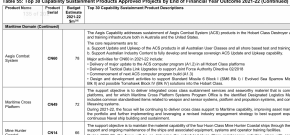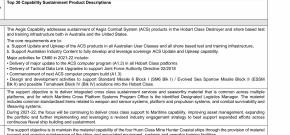ake the NSM as a Harpoon replacement for instance. In addition to acquiring stocks of the missile and establishing training and maintenance programmes for the warstocks, the missile would need to be integrated into the platforms the ADF would utilize it from. In the case of the Hobart-class DDG's and ANZAC-class FFH's, there are specific locations where the quad-cell Harpoon launchers are located.
NSM is designed as a harpoon replacement. NSM is something that would take time to integrate into the various systems. However, harpoon does not seemed longed for this world, and LRASM isn't an ideal replacement for Harpoon as a 1:1 replacement in everywhere harpoon is currently deployed. We are far better off starting this process now, than later. JSM/NSM are items we need to look at sooner rather than later, and while we may not need huge stocks of these types of missiles, they are likely to be very important in the forseeable future.
n addition - @StingrayOZ, how are you paying for it all? Including workforce.
Most of this is acquisition cost, there are minimal manpower requirements. Missiles are ideal from an acquisition point of view as they are mostly a acquisition cost, with minimal ongoing costs, particularly with US kit that is already integrated into the systems the ADF uses (TLAM, SM6, SM3, etc). In other cases expansion of existing platform numbers (p8, F-35 etc). RAAF has 4th squadron planning for several decades now. Other items like trainers, are replacement of existing systems so man power is already there just moving to a new platform.
So these acquisitions can be paid for a number of ways, delay expenditures in other areas of the budget for example. Most of these are already penciled in as acquisitions, it is more about bringing them forward, or moving them from a maybe acquire to acquire.
Unless the design work has already been started, or preferably, been completed, then all that design work for a potential VLS hull plug would need to be done, prior to any kit being ordered or work on implementing such modifications. Given that adding such a hull plug could impact the trim and buoyancy of a sub, as well as the acoustic properties, it is something which should be designed with some care, which would take time.
The ideal location IMO is at the front of the sub, outside the pressure vessel, behind the sonar, like in the early Virginia's. This creates minimal design changes. Yes, buoyancy, acoustic and performance would have be considered, but you are doing that any way with a LOTE Collins program, this incorporated early would result in minimal additional work. The LOTE program isn't without risk, some aspects can effectively be MOTS technologies, launching missiles from a sub isn't new, there are multiple suppliers that can be used, it just needs to be integrated into the design.
Doing this work now on Collins may make more sense than doing this work on the first batch of Attack. If not doing it at all, then we need to accept that we won't have any capability at all until later batches of attack which would see IOC in the late 2030's or 2040's.
Weapons launch is an area where Collins has some advantage over Attack. With only 4 tubes, there is very limited capability to launch any limited strike with the attacks, obviously for France that is not an issue with a carrier, surface fleet and SSBN. Australia doesn't have that kind of capability. Also, if Collins is life extended, we better think about what sort of mission we are likely to give these subs, and due to the slower transit, lower endurance, high noise profile, what missions may be suitable for them in 2030 or 2040. Having them armed with ~8 or so harpoon missiles in vertical tubes, and another four in the front, gives significant first strike capability. These subs may be very useful, not threading the eye of a needle chasing brand new subs and threats, but sitting further off the coast, gathering intelligence, and being a general deterrent. This also de-risks the vertical launch program for the attacks.
The changes have significant acquisition costs, minimal man power costs. But as pointed out, the most significant cost is time. Time to acquire and time to integrate and realize that capability. If we want things operational before the end of this decade then these programs much be initiated now. We are at the point now, where if these programs do not happen in the next ~12 months, they may never happen. We may never see SM-6 missiles integrated into the RAN. We may never see TLAM type capability. We may never see a 4th squadron of F-35, even if we wanted it, and had money for it. etc..
Things like the 4th F-35 squadron, it may be because of logistic issues, that doesn't require any significantly more pilots or maintainer capability for a significant portion of their operational lives, but increases availability of the overall fleet significantly.
Either the conflict comes and later production slots are all gobbled up, or its too late to be useful, or takes too long to integrate. No matter how much money we throw at these project later, they won't be able to be completed. While these OTS type acquisitions often consider that normal world order will continue, that these things will always be available, that we will always be able to ask the US to "jump ahead" and take their slots due to our long and slow acquisition programs (Chinooks, SuperHornets, missiles, it seems every Australian acquisition is uses US build allocations).
That won't be the case forever. If we order in 2023 we might be able to get equipment 2024, if we order in 2025, we might be eligible for equipment in 2035. IMO there is a stronger case for the day moving things forward as part of risk mitigation. My worry is the useful usable window is closing, and that the ADF, as a whole in all services should press to bring acquisitions forward as much as possible particularly in bottlenecked supply chains like advanced missiles, advanced platforms.







